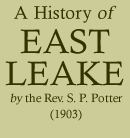< Previous | Contents | Next >
![]()
CHAPTER XIV.
Hill, Road, and Field Names.
NAMES OF ROADS IN THE PARISH.
Woodgate.—Gate, Scandinavian for street or road. Milgateway.—Gate and way are equivalent. There are many instances where a modern word is added to an ancient one instead of being substituted for it, as here and in the next word. Copit Hill is another example.
| The Streetway | } | Roman road.1 |
| The Portway | } |
The Crossway.
Redway.
Hadlandway.
Ristway.—Rist may be Middle English for rest, and point to the resting place of the cattle at noon, in the days before the Enclosure.
Boltwong Lane.
Cockshuttway.—Nuttall gives Cockshutt — a net for woodcocks.
Lantern Lane.
Sheepplank Lane.
Stocking Lane.
Taft Leys Lane.
The Twitchel.
Poke Lane.—Similar names are met with in many parts of the country. Poke, is thought to be a corruption of pook for Puck, a celebrated fairy, the “merry wanderer of the night."
NAMES OF HILLS.
Sharpley Hill.
Hotchley Hill.
Fern Hill.
Copit Hill.—Anglo-Saxon, copy a hill.
Mill Hill.
Rise Hill.
Bloom Hill.
FIELD NAMES.
The three original fields were Woodgate field, Brickliffe field, and Hill field.
Within these enclosures were the following plots which are grouped thus:—
In Brickliffe Field.
Beast Lays (Leys).
Care Furlong.—Pronounced Car. = Either (1) Caer, a castle, or (2) carr, alluvial land.
Upper and Nether Taffs.—The Taffs.
Hall Pike.—cp. the ploughman’s pike or pointed piece of land.
The Sike or White Sike pronounced sick. Sike is Icelandic for a small stream. The Sike is situated by the brooklet which rises at Rempstone.
Town End Pingle.—Pingle means a small piece of enclosed ground.
Monks Meadow.—? The Chanoynes Hokes of earlier days.
Sallow Furlong.—Derivation, either from Anglo-Saxon sealh (Latin salix) a willow, or A.S. salut of a yellow colour.
The Butts Close.—Probably the site of the old archery
grounds, a reminder of legislation of Edward IV.
Castle Close.
Ryholme or Ryham.— Holm, a mound or islet (Norse). Costock Mear.—Mere, either the Anglo-Saxon for pool, or
boundary.
Brickley.
Sweetleys Garner Hedge.
Lings Common.—The Heath, before the Enclosure.
Common Meadow.
Brook Furlong.
Hall Field.
Boar Closes.
Handkerchief Close.
Hill Field.
Copit Hill Common.
Blackley Close.
Thorny Balk.—Balk, a ridge of land left unploughed.
Fern Hill.
Boss Lane Close.
Farthing Leys.—Farthing, fourthing or fourth part, from Anglo-Saxon, feorthing.
Stone Bridge Close.
Hall Meadow Plank.
The Outroves.
Sharpley Nook.
Parson Thorns.
Sharpcliffe.
The Rist.
Watt Furlong.
Hadland End.
Stoney Well.
Blackley.
Bunney Bush.
Hoping or Hooping (or Lime Kiln) Common. Probably from Anglo-Saxon, hop to encircle.
Bull Piece.
Hotchley.—Perhaps equivalent of High Field.
Maggs Hadland.
Moore Close.
Newlocks.
Bush Close.
Rise Leys Common.
Rise Hill Common.
The Rise.
Botham Close.
Stocking Hole.
Head Common.
Taft Leys.
Fishers Close.
Bolt Wong Lane Close.
First and Second Bolt Wong Close.
Top and Middle Holme.
Bottom Holme.
Rowland’s Park.
The Clotter’s Close.
Woodgate Field.
Upper and Nether Poke Furlong.
Poke Lane Pingle.
Cheverall Poole.
Little Dale.
Chauke, Chaulke, Cork Ley and Common.—Misspellings for Calke, the Leicestershire Austin Priory.
Loughborough Balk.
Joyce’s Bush.
Ryham or Ryholme Close.
Flax Lands.—The field where the compulsory cultivation of flax was carried on, under the Act of 24 Hen. VIII. Beggars’ Park.—Park is constantly used as a name for a field. This was called Beggars’ Park because, in times
of distress, the colliers from Coleorton made this spot a meeting place for dividing the spoil obtained by begging.
The Sours.
Twenty Lands.
Debdale Sik.
Crow Meadow.
Lady’s Mear.
Meadow.
Maxley Meadow.
Plain Well Motts Meadow.—Mott may be the equivalent of moot from gemot, a meeting. If so this marks the site of the ancient meeting place of the parish, which commonly was near a well or spring.
Risley or Riseley Meadow.
Washing Meadow.
Carrion Nook.—Where dead animals were buried.
Far and Near Holme.
Moor Meadow.
Weldoles—mispronounced Weldales. Doles = dools and lot lands, assigned by lot to the inhabitants for grass cutting, or cultivation as the case may be.
Close Nook.
The Whins.
Middle Rigs.
Long Hamms and Short Hamms.—“On the outskirts of the arable lands, where the soil is adapted to the pasturage of cattle . . . one or more stinted pastures or hams were laid out for milking cows, working cattle, or other stock which required superior pasturage in summer.”—Marshall, “Treatise on Landed Property,” London, 1804.
(1) See p. 2 and Preface.
